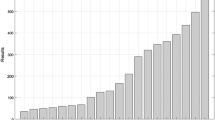Abstract
In this article we examine multicollinearity in the standard OLS interaction-term model—a problem often disregarded by practitioners and in previous research. As a remedy we propose a number of new shrinkage parameters based on the Liu (Commun Stat 22:393–402, 1993) estimator. Using Monte Carlo simulations, we evaluate the robustness of all models for different data-generating processes under varying conditions such as altered sample sizes and error distributions. In the simulation study it is demonstrated that the Liu estimator, which is robust to multicollinearity, systematically outperforms the traditionally applied OLS approach. The simple reason is that interaction models by definition always induce substantial multicollinearity, which in turn distorts the inference of OLS. Conversely, the Liu estimator is robust against multicollinearity in interaction-term models. The advantages of our Liu-based method are also demonstrated in practice when examining the efficiency of the Swedish power retailing market. By the use of this unique data set we find strong evidence of positive asymmetric price transmission effects. Increases in Nord Pool electricity wholesale spot prices lead to immediate and full increases in the electricity retail prices, but decreases in Nord Pool prices are not completely passed down or are delayed before being passed down to consumers. This finding suggests evidence of inefficient and unjust wealth transfers from consumers to retailers in the Swedish power market.
Similar content being viewed by others
Notes
Assume we have a model with a standard interaction-term model specification with two independent variables: one independent variable \((\hbox {x}_\mathrm{t})\) and one interaction term with the same independent variable multiplied by a dummy variable \((\hbox {x}_\mathrm{t} \!\cdot \! \hbox {D}_\mathrm{t})\). If the dummy variable is zero, there are no multicollinearity problems, as the model will simply collapse down to a model with only one independent variable. However, if the dummy is equal to one, the interaction term \((\hbox {x}_\mathrm{t} \cdot \hbox {D}_\mathrm{t})\) is exactly equal to the independent variable \((\hbox {x}_\mathrm{t} \cdot \hbox {D}_\mathrm{t} = \hbox {x}_\mathrm{t} \!\cdot \! 1 = \hbox {x}_\mathrm{t})\). Thus, for those periods when the dummy is equal to one, there is perfect multicollinearity between these two terms. Even though this equals perfect multicollinearity, this model will not break down as there are periods when the dummy is equal to zero. In summary, by definition there will always be severe problems of multicollinearity for this family of interaction-term models, which invalidate the inference part of the regression estimation and make the individual coefficients more uncertain, which is illustrated by the misleading standard errors.
There are around 100 electricity retail companies in Sweden, which are known as ‘Elhandelsbolag’ in Swedish. A retailer ensures that power reaches the end-user. Power is transmitted from the power plant through the central grid and the transmission net to the end-user.
See the ‘About us’ section of the Nord Pool Spot website, at www.nordpoolspot.com.
In the Monte Carlo simulations in this paper, it is demonstrated that D9 is the optimal method.
The applied significance level is \(\alpha =5\,\%\).
Ibid.
References
Akdeniz, F., & Kaciranlar, S. (1995). On the almost unbiased generalized Liu estimator and unbiased estimation of the bias and MSE. Communications in Statistics: Theory and Methods, 24, 1789–1797.
Alheety, M. I., & Kibria, B. M. G. (2009). On the Liu and almost unbiased Liu estimators in the presence of multicollinearity with heteroscedastic or correlated errors. Surveys in Mathematics and its Applications, 4, 155–167.
Damsgaard, N., & Hollmén, S. (2013). ’Marknadsövervakning på den nordiska elmarknaden’, Konkurrensverkets uppdragsforskningsrapport, 4, ISSN: 1652–8069, Swedish Competition Authority.
Ernst & Young (2008), ‘Elhandelsbolagens strategiska agenda - Hur aktörerna förbereder sig inför framtidens elmarknad’, [online] Available: www.kraftaffarer.se/meralasning/ernst&young.pdf.
Frisch, R. (1934). Statistical Confluence Analysis by Means of Complete Regression Systems, Publication 5 Oslo: University Institute of Economics.
Hoerl, A. E., & Kennard, R. W. (1970a). Ridge regression: Biased estimation for non-orthogonal problems. Technometrics, 12, 55–67.
Hoerl, A. E., & Kennard, R. W. (1970b). Ridge regression: Application to non-orthogonal problems. Technometrics, 12, 69–82.
Kaciranlar, S. (2003). Liu estimator in the general linear regression model. Journal of Applied Statistical Science, 13, 229–234.
Khalaf, G., & Shukur, G. (2005). Choosing ridge parameters for regression problems. Communications in Statistics: Theory and Methods, 34, 1177–1182.
Kibria, B. M. G. (2003). Performance of some new ridge regression estimators. Communications in Statistics: Theory and Methods, 32, 419–435.
Liu, K. (1993). A new class of biased estimate in linear regression. Communications in Statistics: Theory and Methods, 22, 393–402.
Månsson, K., Kibria, B. M. G., & Shukur, G. (2012). On Liu estimators for the logit regression model. Economic Modelling, 29, 1482–1488.
Meyer, J., & von Cramon-Taubadel, S. (2004). Asymmetric price transmission: A survey. Journal of Agricultural Economics, 55(3), 581–611.
Muniz, G., & Kibria, B. M. G. (2009). On some ridge regression estimators: An empirical comparison. Communications in Statistics: Simulation and Computation, 38, 621–630.
Swedish Competition Authority (2007). Marknadsandelar och elhandelsmarginaler för E.ON, Fortum och Vattenfall, Dnr 408/206.
Acknowledgments
We would like to gratefully acknowledge the support of the Torsten Söderberg Foundation.
Author information
Authors and Affiliations
Corresponding author
Rights and permissions
About this article
Cite this article
Shukur, G., Månsson, K. & Sjölander, P. Developing Interaction Shrinkage Parameters for the Liu Estimator — with an Application to the Electricity Retail Market. Comput Econ 46, 539–550 (2015). https://doi.org/10.1007/s10614-014-9458-3
Accepted:
Published:
Issue Date:
DOI: https://doi.org/10.1007/s10614-014-9458-3




